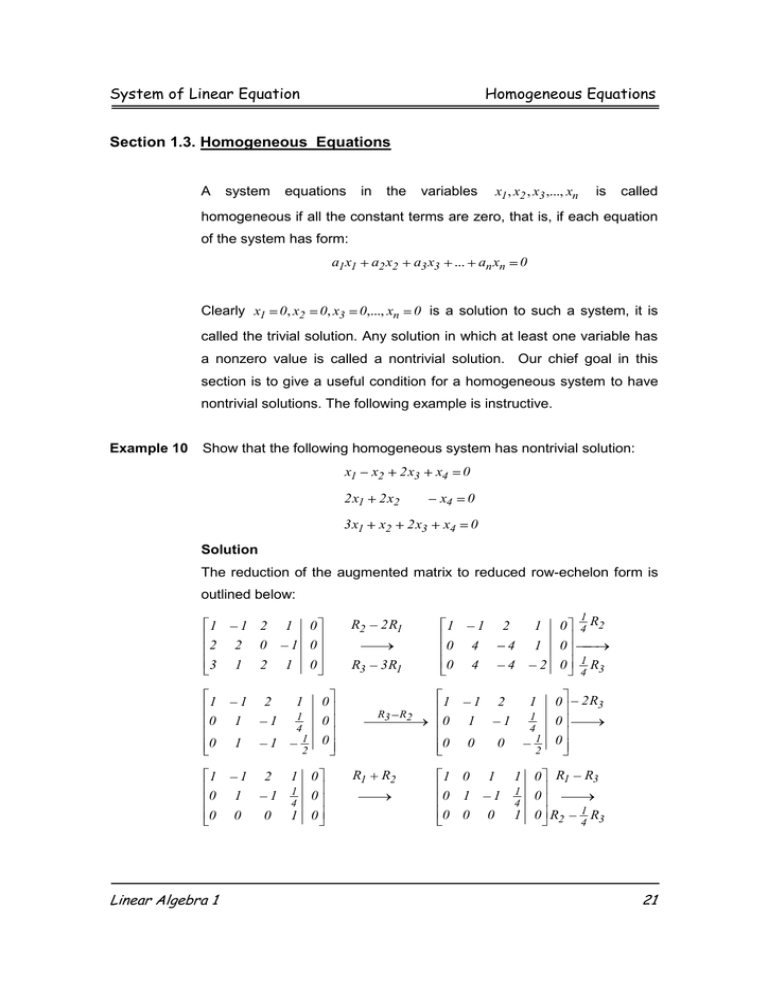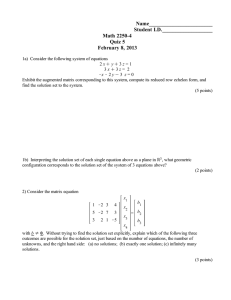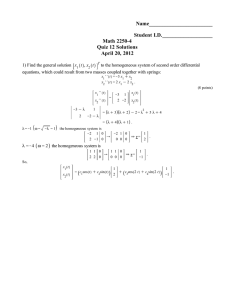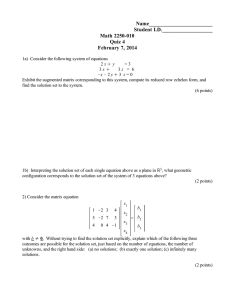System of Linear Equation ... Section 1.3. Homogeneous Equations
advertisement

System of Linear Equation Homogeneous Equations Section 1.3. Homogeneous Equations A system equations in the variables is x1 , x2 , x3 ,..., xn called homogeneous if all the constant terms are zero, that is, if each equation of the system has form: a1x1 Clearly x1 0, x2 0, x3 a2 x2 a3 x3 ... an xn 0 0 is a solution to such a system, it is 0,..., xn called the trivial solution. Any solution in which at least one variable has a nonzero value is called a nontrivial solution. Our chief goal in this section is to give a useful condition for a homogeneous system to have nontrivial solutions. The following example is instructive. Example 10 Show that the following homogeneous system has nontrivial solution: x1 x2 2 x3 2 x1 2 x2 3 x1 x2 2 x3 x4 0 x4 0 x4 0 Solution The reduction of the augmented matrix to reduced row-echelon form is outlined below: 1 2 3 1 2 2 0 1 2 1 0 1 1 2 1 0 1 1 1 0 0 1 1 0 2 1 0 Linear Algebra 1 1 0 1 0 1 0 1 1 4 1 2 1 0 1 0 4 1 0 R2 2 R1 R3 3 R1 0 0 0 R3 R2 R1 R2 1 0 0 1 4 4 1 0 1 1 2 1 0 0 0 1 0 0 1 0 0 2 4 4 1 1 0 1 1 0 4 R2 1 0 2 0 1 R3 4 1 1 4 1 2 0 0 0 2 R3 1 0 R1 R3 1 0 4 1 0 R2 1 R3 4 21 System of Linear Equation 1 0 0 1 0 0 Homogeneous Equations 1 0 0 1 0 0 0 1 0 The leading variables are x1, x2 , x4 , so x3 is assign as a parameter, say x3 t . Then the general solution is x1 t , x2 t , x3 t , x4 0 . Hence, taking t 1 , we get a nontrivial solution. The existence of a nontrivial solution in Example 1 is ensured by the presence of a parameter in the solution. This is due to the fact that there is a non leading variable ( x3 in this case ). But there must be a non leading variable here because there are four variable and only three equations ( and hence at most three leading variables ). This discussion generalizes to a proof of the following useful theorem. Theorem 1 If a homogeneous system of linear equations has more variable than equation then it has a nontrivial solution ( in fact, infinitely many) Proof: Suppose there are m equations in n variables where n m , and let R denote the reduced row echelon form of the augmented matrix. If there are r leading variables, there are n-r non leading variables, and so n-r parameters. Hence, it suffices to show that r<n. But r m because R has r leading 1’s and m rows and m<n by hypothesis. Note that the converse of Theorem 1 is not true: if a homogeneous system has nontrivial solutions, it need not have more variables than equations. Linear Algebra 1 System of Linear Equation Homogeneous Equations Exercises 1.3 Ohm’s Law Kirchhoff’s Law The current I and a voltage drop V across a resistance R are related by the equation V =RI 1. ( Junction Rule ): The current flow into a junction equals the current flow out of that junction. 2. ( Circuit Rule ) The algebraic sum of the voltage drops ( due to resistance ) around any closed circuit of the network must equal the sum of the voltage increases around the circuit. 1. Find the various current in the circuit shown: 2. Find the various current in the circuit shown: 3. Find the row equations : echelon form of the augmented matrix of this system of linear x y z 3 x 4 y 5z 2 x 6 y 3z 4 4. Carry of that augmented matrix ( in the previous exercise ) to reduced row - echelon form. 5. Find ( if possible ) conditions on a, b, c such that the system has no solution, one solution, or infinitely many solutions: 3x y z a x y 2z b 5x 3 y 4z c Linear Algebra 1




